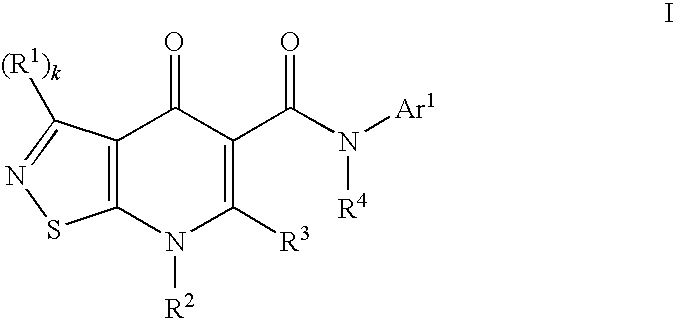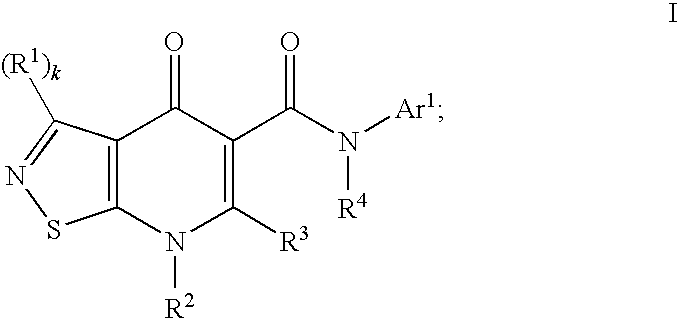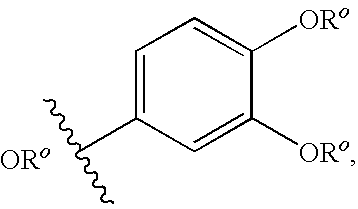Isothiazolopyridinones useful for the treatment of (inter alia) cystic fibrosis
a technology of isothiazolopyridinone and cystic fibrosis, which is applied in the field of modulators of cystic fibrosis transmembrane conductance regulators, can solve the problems of imbalance in ion and fluid transport, debilitating and fatal effects of cf, and reducing anion transport, so as to reduce the severity
- Summary
- Abstract
- Description
- Claims
- Application Information
AI Technical Summary
Benefits of technology
Problems solved by technology
Method used
Image
Examples
example 1
Preparation of 3-methyl-4-oxo-4,7-dihydroisothiazolo[5,4-b]pyridine-5-carboxylic acid
[0219]
[0220]3-Methylisothiazol-5-amine hydrochloride (25.0 g, 166.0 mmol) was dissolved in toluene (100 mL) and pyridine (13.45 g, 13.75 mL, 170 mmol), then treated with diethyl 2-(ethoxymethylene)malonate (38.92 g, 36.07 mL, 180 mmol). The reaction mixture was heated at reflux for 16 h. The solvent was evaporated and the residue purified by silica gel chromatography (0-100% hexane-ethyl acetate, 1.5 kg silica) to yield diethyl 24(3-methylisothiazol-5-ylamino)methylene)malonate (40.0 g, 85% yield). LC / MS m / z 285.2 [M+H]+, retention time 1.36 min (RP-C18, 10-99% CH3CN / 0.05% TFA over 3 min).
[0221]Diethyl 2-((3-methylisothiazol-5-ylamino)methylene)malonate (10 g, 35.17 mmol) was added to refluxing diphenyl ether (40 mL) and the reaction was held at reflux (259° C.) for 3.5 h. After the starting material had been consumed, the reaction was allowed to cool to room temperature. The product was precipitate...
example 2
Preparation of N-(3-tert-butyl-1H-indol-6-yl)-3-methyl-4-oxo-4,7-dihydroisothiazolo[5,4-b]pyridine-5-carboxamide (Compound 2, Table 1)
[0223]
[0224]3-Methyl-4-oxo-4,7-dihydroisothiazolo[5,4-b]pyridine-5-carboxylic acid (100.0 mg, 475.7 μmol) and 3-tert-butyl-1H-indol-6-amine (89.56 mg, 0.4757 mmol) were added to a 20-mL vial and suspended in 2-methyl THF (1 mL), followed by propane phosphonic acid anhydride (T3P®, 50% solution in ethyl acetate, 757 mg, 1.19 mmol). Pyridine (75.26 mg, 76.95 μL, 951.4 μmol) was then added and the solution heated at 45° C. for 16 h. The reaction was diluted with 5 mL ethyl acetate and washed with water (1×10 mL). The organic layer was pulled off and concentrated. The residue was dissolved in 6 mL DMF and HPLC purified (RP-C18, 20-99% CH3CN / 0.05% TFA). The pooled product fractions were concentrated to approximately 5 mL to provide a suspended white solid. The suspended material was filtered, washed with water and air dried to yield the product N-(3-tert-b...
PUM
| Property | Measurement | Unit |
|---|---|---|
| Mass | aaaaa | aaaaa |
| Mass | aaaaa | aaaaa |
| Mass | aaaaa | aaaaa |
Abstract
Description
Claims
Application Information
 Login to View More
Login to View More - R&D
- Intellectual Property
- Life Sciences
- Materials
- Tech Scout
- Unparalleled Data Quality
- Higher Quality Content
- 60% Fewer Hallucinations
Browse by: Latest US Patents, China's latest patents, Technical Efficacy Thesaurus, Application Domain, Technology Topic, Popular Technical Reports.
© 2025 PatSnap. All rights reserved.Legal|Privacy policy|Modern Slavery Act Transparency Statement|Sitemap|About US| Contact US: help@patsnap.com



